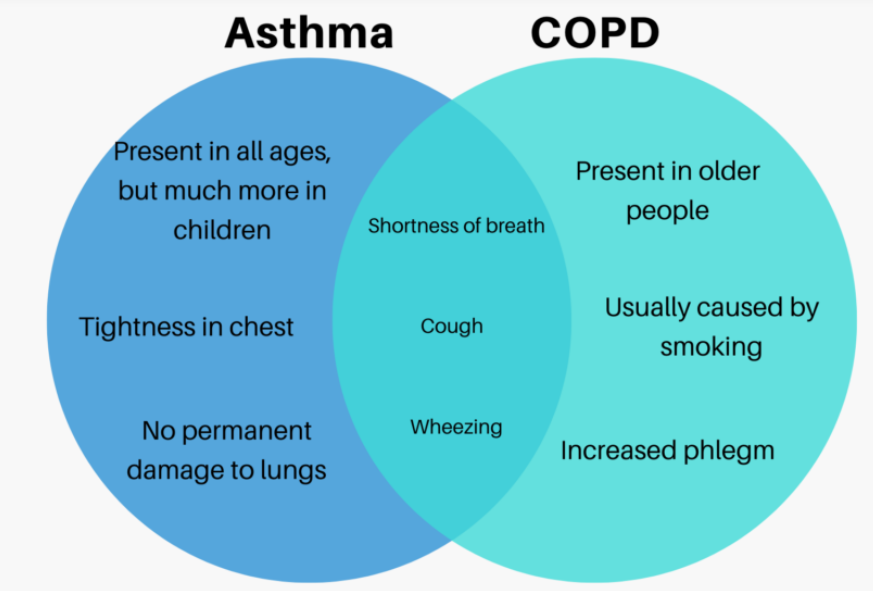Speaking of COPD and asthma, I believe everyone is familiar with them. They are both common diseases of the respiratory system. The two have many similarities in clinical manifestations, therapeutic drugs, pathogenesis, etc., and are easy to confuse. But in essence, the two are different diseases, and the treatment methods are also different.


Speaking of COPD and asthma, I believe everyone is familiar with them. They are both common diseases of the respiratory system. The two have many similarities in clinical manifestations, therapeutic drugs, pathogenesis, etc., and are easy to confuse. But in essence, the two are different diseases, and the treatment methods are also different.
Onset time
There is a big difference between the two in terms of onset time. Usually, COPD begins to develop in middle-aged and elderly people, while asthma generally develops in infants and young children.
Concomitant diseases
Most asthma patients are accompanied by other allergic diseases, such as allergic rhinitis or eczema. COPD patients almost never have these diseases, mainly due to environmental factors or smoking habits.
Reversibility
This is the core difference between asthma and COPD. Asthma patients often show sudden dyspnea, but after antiasthmatic treatment, they can be completely relieved, and sometimes they can even be relieved by themselves. The symptoms of COPD are chronic, and the symptoms will persist, and there is often no complete remission period.
In terms of lung function, the onset of asthma patients is often accompanied by a decline in lung function, and after treatment, the lung function can return to normal. The prominent feature of COPD is that airflow obstruction is irreversible. Once COPD is diagnosed, even with standardized treatment, lung function will decline year by year and is irreversible.
Differences in pulmonary function tests
In pulmonary function tests, asthma patients often show positive results in airway provocation tests and diastolic tests. The main feature of COPD patients' lung function is a continuous decline in the rate of one second, while diastolic tests and provocation tests are mostly negative.
Family inheritance characteristics
Asthma patients are a disease with obvious family inheritance, which is closely related to genetic factors. Although COPD has the characteristics of family distribution, it is more affected by external environmental factors and living habits.
Understanding asthma
Asthma is an inflammation of the airways that causes symptoms such as coughing, sputum, shortness of breath, wheezing (wheezing when breathing) and chest tightness. Here, we will discuss the basics of asthma, including its causes and symptoms.
What is airway inflammation?
The respiratory tract is the passage through which breathed air passes, mainly the bronchi. From the inside, the bronchi are composed of mucosa, submucosal layer and smooth muscle (muscle).
Inflammation means swelling and redness. Even when there is no attack, the airways of asthma patients are inflamed, sensitive, and reactive to even the slightest irritation. When bronchial inflammation worsens, the mucosa swells, causing phlegm and coughing, and smooth muscle contraction further narrows the airways. This makes it difficult for air to pass through and leads to various symptoms of asthma, such as wheezing and shortness of breath.
Understanding COPD
It is a common chronic disease of chronic bronchitis and/or emphysema with airflow obstruction, which can further develop into cor pulmonale and respiratory failure.
Symptom Differences
Both COPD and asthma narrow the bronchi and make it difficult to exhale. However, in the case of asthma, the symptoms are transient and allergic symptoms occur. The attack is sudden, but the symptoms disappear after the allergic reaction subsides.
COPD, on the other hand, can flare up from time to time, but it gets worse gradually over time.
Coughing and sputum are the main symptoms other than exhaling. In COPD patients, coughing is often accompanied by choking, but in asthma patients, once the cough starts, it becomes uncontrollable.
As for sputum, COPD produces more sticky sputum. Asthma also produces sputum, but not as much.
Differences in lung function
Except for asthma that progresses to bronchial constriction, asthma usually causes little change in lung function tests or only mild breathing abnormalities during the absence of an attack.
COPD, on the other hand, causes permanent breathing abnormalities, and test results get worse over time.
The difference in oxygen uptake is also significant. In asthma patients without alveolar damage, abnormal blood oxygen levels are rarely seen. In COPD, on the other hand, the alveoli are damaged and cannot absorb oxygen, so the oxygen level in the blood is usually low.
Differences in smoking history
COPD is most often caused by smoking. Since the disease progresses gradually with smoking, most people with COPD have a long history of smoking.
In the case of asthma, smoking is not related to onset, so symptoms usually appear without a history of smoking. In addition, many smokers with asthma will have an attack due to smoking, and some people quit smoking when an attack occurs.
Age difference
Since COPD is a disease that develops due to accumulation over many years, the number of people with COPD will inevitably increase with age. Specifically, it occurs more in people over 60 years old, while COPD needs to be treated at a young age, mainly in people who smoke more or whose alveoli are weak to begin with.
On the other hand, asthma is an allergic reaction, so it usually develops at a young age. Childhood asthma also exists, but in childhood asthma, the immune response is enhanced with age and symptoms tend to subside.
What do asthma and COPD have in common?
Asthma and COPD are diseases that make it difficult to exhale. In both cases, bronchial inflammation is involved, so the test results when symptoms occur are the same.
Smoking is also a factor that aggravates asthma, so COPD and asthma may coexist.
Therefore, depending on your age and smoking history, it is often difficult to simply say "you have COPD" or "you have asthma." Especially as you get older, when you think you have COPD, you may find that you have asthma.
Winter is here, especially for COPD overlap syndrome (ACOS), pay attention to weather changes, reduce smoking, avoid secondhand smoke stimulation, and don't go to crowded places.


